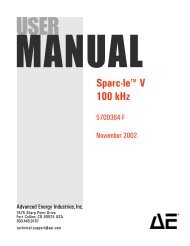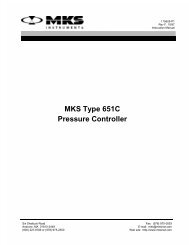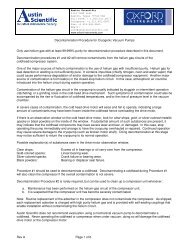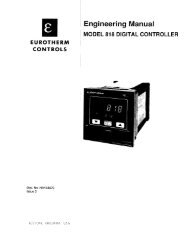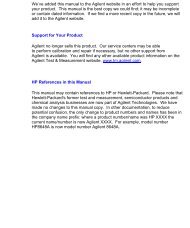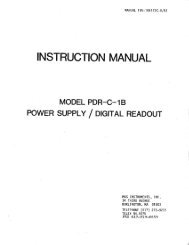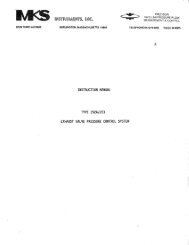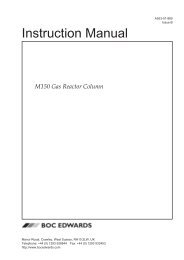March CS 1701 RIE Operations and Maintenance Manual
March CS 1701 RIE Operations and Maintenance Manual
March CS 1701 RIE Operations and Maintenance Manual
- No tags were found...
You also want an ePaper? Increase the reach of your titles
YUMPU automatically turns print PDFs into web optimized ePapers that Google loves.
BASIC ELEMENTS OF PLASMA TREATMENTTo plasma treat a sample in the <strong>CS</strong>-<strong>1701</strong>, the basic steps are:1. Place the material to be treated into the chamber.2. Seal the vacuum chamber by closing the lid.3. Pump the vacuum chamber down to a low, preset pressure level.4. Introduce a process gas or gases into the chamber.5. Apply RF energy to the low pressure gas in the chamber to light the plasma.To end the process:1. Stop applying RF energy to the chamber.2. Stop the flow of process gases.3. Bleed the chamber back to atmospheric pressure.4. Open the vacuum chamber.5. Remove the treated material from the chamber.CAUTION: THE CHAMBER CAN BECOME VERY HOT DURING SOMEPROCESSES. EXERCISE CAUTION TO PREVENT BURNS.These steps are flow charted on the next page.In order to develop <strong>and</strong> optimize a plasma process for a given material, the operatorhas the ability to alter the following parameters:• Process gas(es) selected for use.• Flow rate/pressure of selected gas(es).• Amount of RF energy applied to the vacuum chamber.• Amount of time material is exposed to the plasma.• Vacuum chamber threshold pressure (the pressure setting that must be achievedbefore the process can start).Process pressure, RF power, <strong>and</strong> treatment time are the primary factors that affect theintensity of the treatment. For example, a high energy treatment would be run underconditions of relatively low pressure, high power, <strong>and</strong> long treatment time. Conversely,a low energy treatment would be run under conditions of relatively high pressure, lowpower, <strong>and</strong> a short treatment time.Since every material has different treatment requirements <strong>and</strong> many factors need to betaken into account, it is difficult to say what type of treatment will give the desiredresults. A general rule would be that energetic processes are better for cleaning <strong>and</strong>etching applications; more moderate processes are better for surface activationapplications.33




